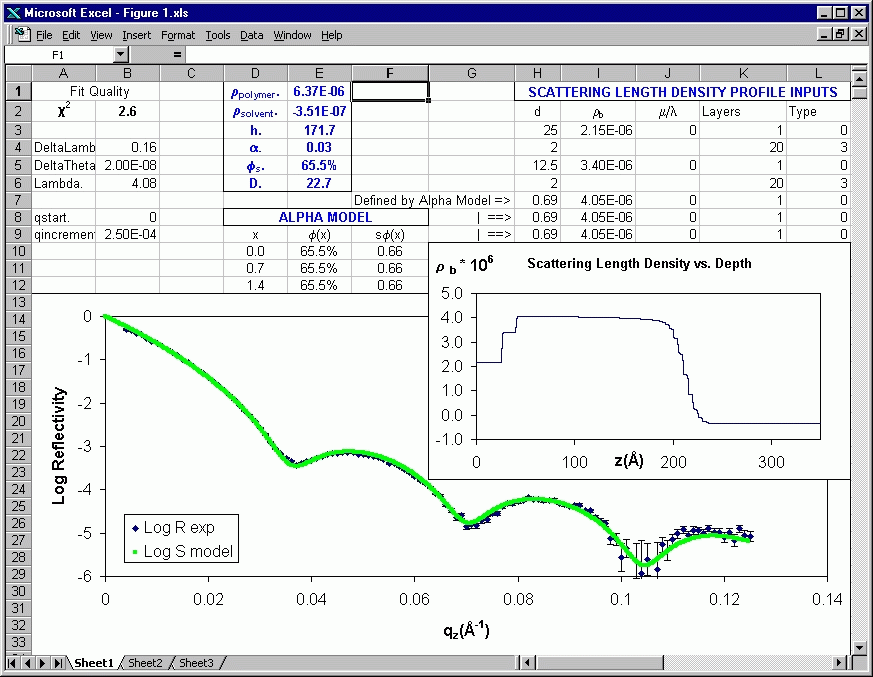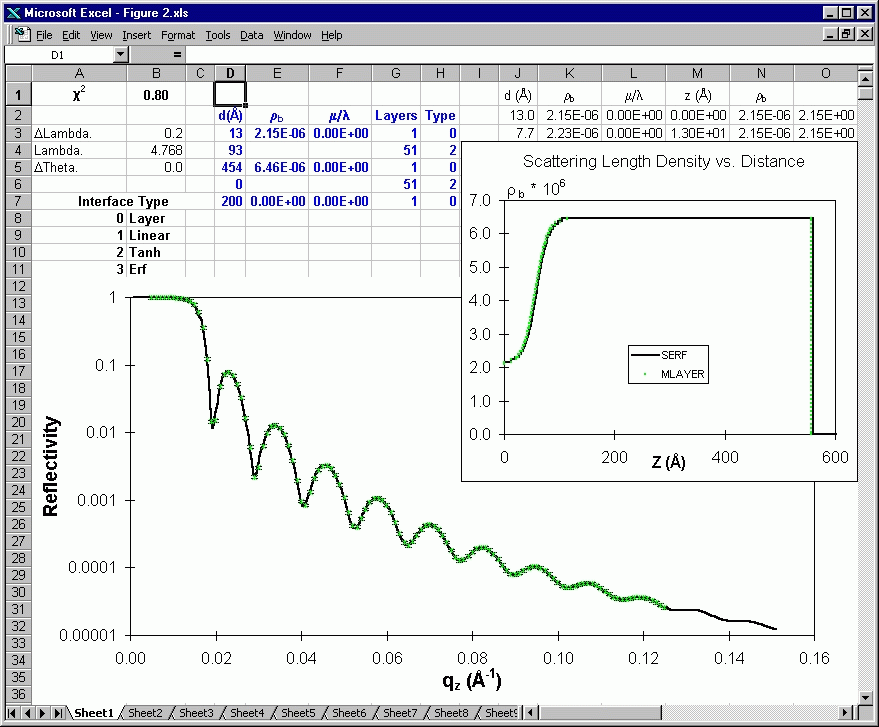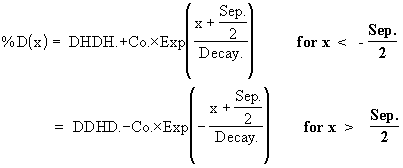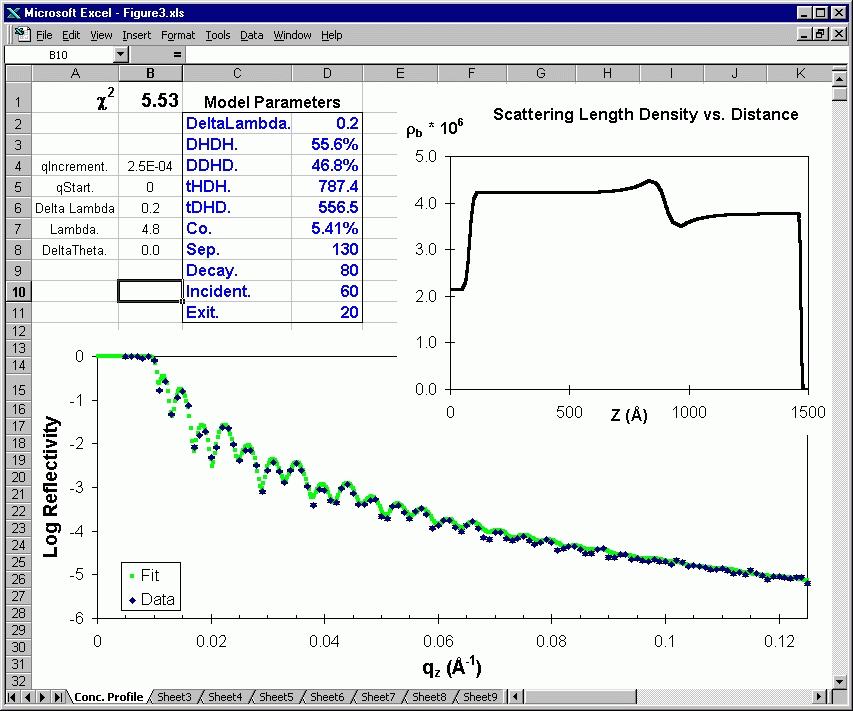 (1)
(1)Keywords: reflectivity, neutron, x-ray, spreadsheet, fitting, Solver, GRG2, Parratt formalism.
Abstract
Specular reflectivity experiments have been very successful in the depth
profiling of various materials. The inversion problem requires, in general,
model fitting. Fitting programs for reflectivity are available at research
institutions operating reflectometers, or with commercial instruments.
The existing software for reflectivity fitting has proven to be very successful
for layered model profiles, however, these programs can be cumbersome in
their command structure. Additionally, they do not offer easy use of generic
functions (e.g. parabolic profiles) as model profile inputs. Here we attempt
to overcome these difficulties by utilizing the advantages of a commonly
available spreadsheet as the host environment for fitting. SERF (Spreadsheet
Environment Reflectivity Fitting) is comprised of "add-in" functions capable
of calculating realistic reflectivity profiles from model scattering length
density profiles. The spreadsheet environment offers simultaneous display
of numeric and graphical data, and automatic calculation and graph updates
when a parameter is changed. These features improve the efficiency of data
fitting. Additionally, and most significantly, this method allows flexibility
in the profile shapes which can be inputted. The ability to input model
profiles, with specific functional forms, simply, may lead to better understanding
of data obtained from reflectivity experiments.
Introduction
Specular reflectivity is a powerful depth profiling technique for a
variety of materials. By monitoring the ratio of reflected to incident
intensity, R, as a function of the perpendicular component of the wavevector,
qz (inverse length), information about the depth profile in
a sample can be obtained. Variation in qz, is achieved either
by variation in the angle of incidence and reflection (monochromatic source),
or by changing the wavelength (time of flight source). Contrast is imparted
by differences in neutron scattering length density for neutron sources
or electron density for x-ray sources. This contrast produces oscillations
in the reflectivity data, characteristic of composition depth profile in
the sample. Detailed treatments of the technique can be found in the literature.[1-3]
The technique offers very high resolution, down as small as a few angstroms,
with depth penetrations of several thousand angstroms. Typically there
is nominal beam damage to the sample, allowing sequential analysis of a
single sample after various treatments. Reflectivity versus wavevector
data do not include phase information, and therefore can not be directly
inverted to composition versus depth, except in a few special cases.[3]
Consequently, this inversion must be accomplished via model fitting. In
this work we have worked to improve the speed and flexibility of the tools
used to perform these fitting operations, hopefully further extending the
usefulness of the reflectivity technique.
Fitting programs for reflectivity are available at research institutions
operating reflectometers, or commercially with the instruments themselves.
The fitting programs from the NIST Cold Neutron Research Facility (CNRF),
with which these authors are familiar with, are either Unix or DOS based,
and have proven to be very successful in fitting layered structures. Despite
this success, these programs have a relatively cumbersome command structure,
and do not offer flexibility in the model profile shapes allowed as inputs.
By developing "add-in" functions capable of calculating realistic reflectivity
profiles from model scattering length depth profiles within a commonly
available spreadsheet (Microsoft Excel®) performance is
improved. The spreadsheet environment offers simultaneous display of numeric
and graphical data, as well as automatic calculation and graph update upon
the change of a parameter. An additional advantage is the ability to simply
input specific functional forms for the scattering length density profile.
The following will detail the methods used to calculate profiles and give
examples of SERF (Spreadsheet Environment Reflectivity Fitting).
Method
The general approach used herein is to utilize the spreadsheet as a
powerful front end for a series of add-in functions which calculate reflectivity
profiles. All of the functions described are Fortran 90 based. The compilation
is done such that the spreadsheet program can call the executable code,
similar to commonly used functions like "slope" that are packaged with
commercial spreadsheets. All information is passed from the spreadsheet
to Fortran using OLE2 and array formulas, provides efficient data transfer,
and rapid calculation, even for complicated models. Reflectivity is calculated
using the formalism developed by Parratt,[4] with the addition of absorption
terms. This approach takes input as layer thickness, d(Å), scattering
length (or electron) density, rb
(Å-2), and adsorption coefficient over wavelength, (m/l),
for a series of layers. Any arbitrary scattering length density profile
can be input by utilizing a series of thin layers which have scattering
length densities defined by some generic function rb(x).
In the study of grafted polymer layers in mixed solvents, the volume fraction
of the polymer can be calculated from the alpha model, Equation 1.
 (1)
(1)Figure 1 demonstrates the use of SERF to calculate reflectivity using Equation 1 as an input model. The polymer volume fraction, Equation 1, is calculated in columns D through F, below row 8. The third column, F, performs a Gaussian smearing on the alpha profile. Column F is then used to define the scattering length profile inputs in column I. This profile is then used to generate a model reflectivity, and compared to experimental data for a deuterated poly(styrene) grafted layer in 75:25 methanol cyclohexane, Figure 1. The width of the smearing function, D., the height of the brush, h., alpha, a., and the volume fraction of polymer at the silicon surface, fs, are used as adjustable parameters in fitting. To account for instrumental smearing effects the bare reflectivity is treated with a Gaussian smearing function.[5] This smeared reflectivity, as well as the experimental data, are plotted as Log Reflectivity vs. qz, in Figure 1.

Additionally, traditional gradient layers (roughness) with linear,
tanh, or erf functional forms have been coded for convenience in the profile
interpretation functions. Gradient layers are calculated by value matching
to the two adjacent plateau layers (type 0), uniformly sectioning the change
in scattering length density, and calculating the layer thickness based
on the functional form (type 1,2,3), thickness of the gradient region (d(Å)),
and the number of steps which discretize the gradient region (layers),
all of which are user inputs. Figure 2 shows a simple profile setup using
these gradient layers, for a 500Å deuterated poly(styrene) layer
on silicon, with beam impinging from air side. As discussed above, the
user assigns the thickness of the gradient regions. The assignment of this
thickness does not affect the thickness of the adjacent layers, unlike
other fitting programs, which create gradient regions by subtracting equally
from the adjacent layers. This allows the user to account for nonuniform
effects of roughness on the two adjacent layers. Additionally, "Data" in
Figure 2 has been calculated using the same model parameters (except for
roughness due to the difference in definition discussed above) and imported
to the spreadsheet from a fitting program used at NIST, mlayer©,
as a check of these functions. Chi-squared, c2
, the sum of the squared differences between SERF and mlayer©
values, divided by a small error allowance, is less than 1, indicating
the excellent fit, which can also be seen in the plot of Reflectivity versus
qz. Similar qualification has been performed for air and silicon
side measurements for bare reflectivity without roughness, smeared reflectivity
without roughness, rough layers without smearing, and finally the combination
of all functions, as seen in Figure 2.

Figure 2: Screen shot from Microsoft Excel®
demonstrating the ability of SERF in handling traditional layer profiles.
Data are taken from a proven fitting program, mlayer©,
and are indicated in green. The inputs to SERF are indicated in blue, outputs
are plotted as scattering length density vs. distance and Reflectivity
vs. qz(Å-1). The excellent "fit" is indicative
of identical predictions from SERF and mlayer©.
Fitting is accomplished using the Solver routine packaged with Microsoft
Excel®. Solver is a powerful nonlinear least squares
fitting routine. It allows minimization of any function, defined within
a spreadsheet cell, by changing any number of parameters. A common example
is minimization of c2 in Figure 2,
by changing the thickness of the gradient and bulk layers. Each of these
parameters can also be subjected to constraints, a feature not allowed
in some programs. The solver routine is based on the GRG method[6-7], and
has been developed by Frontline Systems.[9]
Welp, et al. [8] have used these functions for fitting neutron reflectivity data for a very specialized experiment which directly probes the dynamics of a polymer chains at a polymer-polymer interface in the melt. The samples are composed of two layers of triblock poly(styrene) which are each ~50% deuterated. They differ in the section of the chain that is deuterated. Because of the triblock labeling, the scattering length profiles expected in these samples are complex. Figure 3 shows the profile used and a representative fit to a data file, obtained at NIST CNRF. The profile is composed of two decaying exponential terms determining the deuterium fraction in a given thin layer, Equation 2, and three error function gradient regions.
 (2)
(2)The incident medium is silicon, indicated at the left of the scattering
length density vs. depth profile, and the final layer is air, at the extreme
right. The variables in the model are noted in blue in Figure 3, and include
the composition of the two polymer layers, DHDH. and DDHD., excess concentration
caused by interdiffusion, Co., decay constant of the exponential terms,
Decay., and thickness of the three gradient layers, IncidentRough., Sep.,
and ExitRough., for the Si/polymer, polymer/polymer, and polymer/air interfaces,
respectively. These fitting tools were essential for this research as they
allowed calculation of reflectivity from this complex profile that could
be readily inputted. The ability to alter any of the parameters shown in
boldface print in Figure 3, and see immediate update of the fit quality,
both graphically and numerically, has provided much information as to the
sensitivity of the fit to the various parameters.

Figure 3: Screen shot from Microsoft Excel®
demonstrating the use of SERF for polymer interdiffusion experiments with
complex scattering length density profiles. The deuterium concentration
profile is a function of parameters, in blue, and given by Equation 2.
The scattering length density profile plot is derived from the deuterium
depth profile by a SERF function. Model reflectivity, in green, is calculated
and plotted along with experimental data as Log Reflectivity vs. qz(Å-1).
Conclusion
This paper has briefly listed the approach and capabilities of a new
series of fitting tools for reflectivity data. This approach has proven
to be more user friendly than other approaches. It allows complete flexibility
in the type of profiles that can be inputted. Additionally, once a profile
has been defined in terms of a few parameters, immediate recalculation
and update of all figures follow a change to any of the parameters. This
gives the user an immediate feel for the effect of a given parameter on
the model profile without cumbersome commands required to display data
in other implementations.
Additional information, instructions, and free download of all functions
are available at http://www.kalergroup.che.udel.edu/KalergroupWebPage/Software/SoftwareIndex.htm
Acknowledgments
Funding support for K.A.Welp from NSF, grant DMR-9596-267, and for C.
Co from NSERC (National Science and Engineering Research Council of Canada).
K.A.W. would like to thank support from the Delaware Space Grant College
Fellowship Program. The authors would also like to acknowledge the help
and advice of S. K. Satija.
References